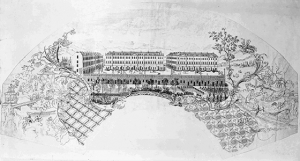Social life in eighteenth-century Bath
Descriptions of Bath:
Society life:

- North Parade
- Thomas Robins Sr North Parade, a fan
[click on the picture to enlarge it]
Robins also depicted the baths. North Parade was painted by Cozens.
The parades are described by Smollett’s character Lydia; they appear in Sheridan’s The Rivals.
The visits of Queen Anne and her husband to Bath in 1702 and 1703 drew towards the city the aristocracy soon followed by the gentry.
Bath also owed its development to the influence of the medical profession: drinking the waters was prescribed, in addition to bathing (first Pump Room: 1705)
Under the guidance of the Master of Ceremonies Richard Nash (known as “Beau Nash”, 1674-1761) daily life flourished and was codified. A daily agenda was established, in which everyone was bound to take part. The first Assembly Rooms were built in 1706.
In 1727, John Wood returned to his native region and conceived the bold design of a new classical town on the Palladian model. The Parades were planned as the “Forum” on the Ancient model.
Bath however became a victim of its success. Middle-class people started crowding there and in the latter part of the 18th century, socially disparate groups haunted the Pump Room and the Assembly Rooms, an evolution mentioned in Smollett’s novel Humphry Clinker.

